The United States Marine Corps’ Operational Test and Evaluation Squadron One (VMX-1) spends most of its time trialing and evaluating new hardware, weapons, and software updates for Marine aircraft. In between all of those testing events, leaders at the squadron came up with an organic effort to bring in all of their assets for an ongoing test event with a heavy focus on Expeditionary Air Basing Operations (EABO) which is a major initiative that could prove essential to winning a war in the Pacific.
Author’s note: This is the second in a multi-part series covering VMX-1’s highly unique mission, diverse stable of aircraft, and the critical role it is playing to shape the future of Marine Corps aviation. You can check out the first installment here.
EABO involves the employment of highly mobile, low-signature forces from a series of austere, temporary locations ashore or inshore within an enemy’s weapons engagement zone (WEZ), in order to conduct a host of missions, before quickly breaking down and moving to another area before being targeted.
Think rapidly hopping from island base to island base so that you can strike at the enemy where it matters, while not giving them enough time to wipe you out.
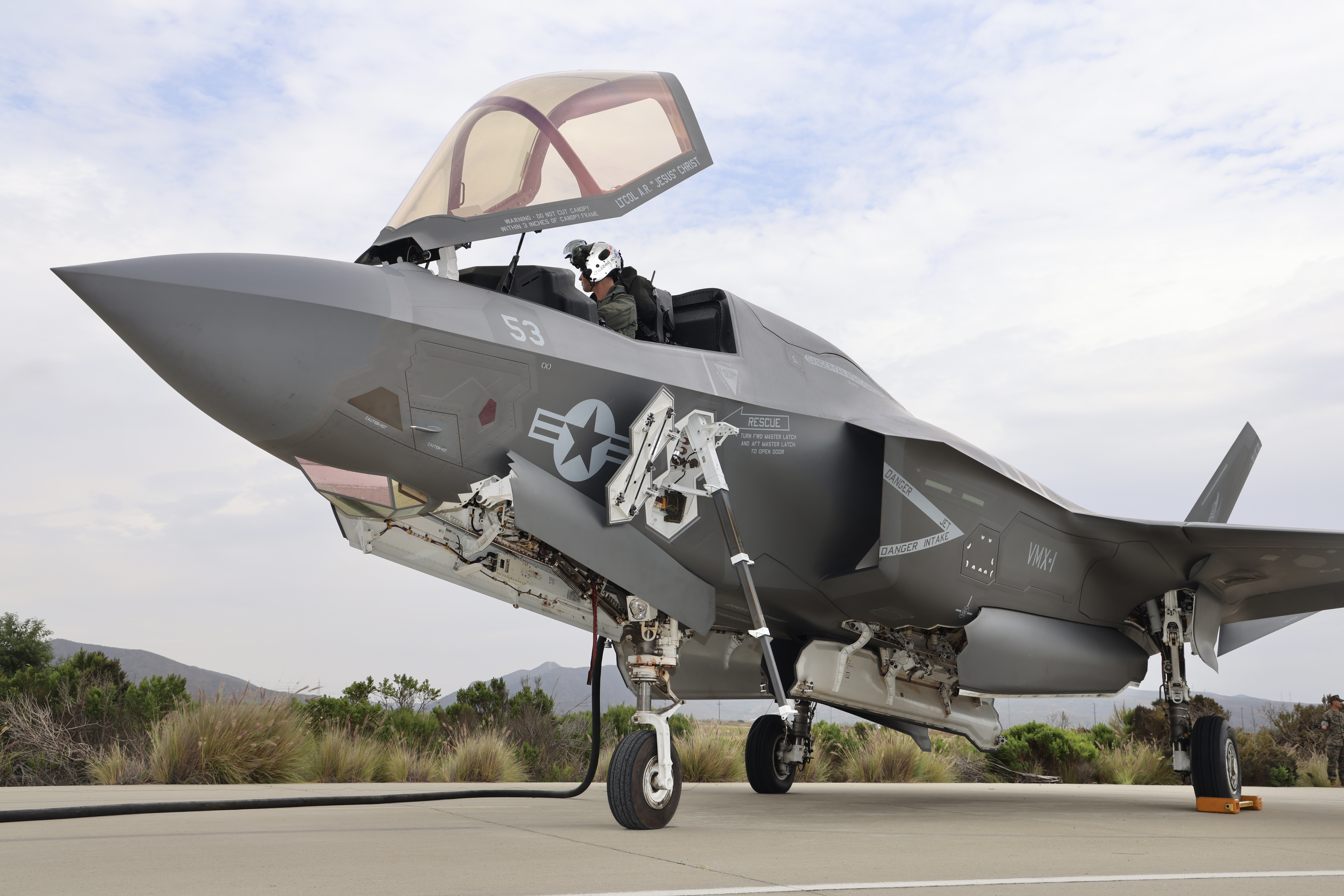
The test event known as ‘Obsidian Iceberg’ has been covered by The War Zone in the past, but this most recent iteration covered two days and brought in nine squadrons and other units from the Marines, Air Force, and Navy to execute a unique set of trials and training events that will have a huge impact on the future of the USMC’s flying forces.
The War Zone sat down with VMX-1’s Operational Test Director, Lt. Col. Robert ‘Champ’ Guyette, to discuss it.
Guyette explained, “The mission of Obsidian Iceberg is to develop the tactics, techniques, procedures (TTPs) for expeditionary air basing — specifically, the node. So there’s three echelons of EABO. Hub, spoke and node. The hub is more like a Wing operating or maybe a Marine Air Group (MAG). A spoke would be kind of a MAG with a reinforcement with a Marine Aviation Logistics Squadron [MALS] where squadrons would recover there overnight. And then a node is way out there at the tactical edge, similar to a Forward Arming Refueling Point [FARP], but more mobile and [with] less of a footprint… signature. What I mean by signature is time signature, radio frequency spectrum signature, audio signature, visual signature. It’s about just getting up, getting what we need to get done and getting out. The node is very, very close to the fight and something that can be dynamically selected using the command and control system.”
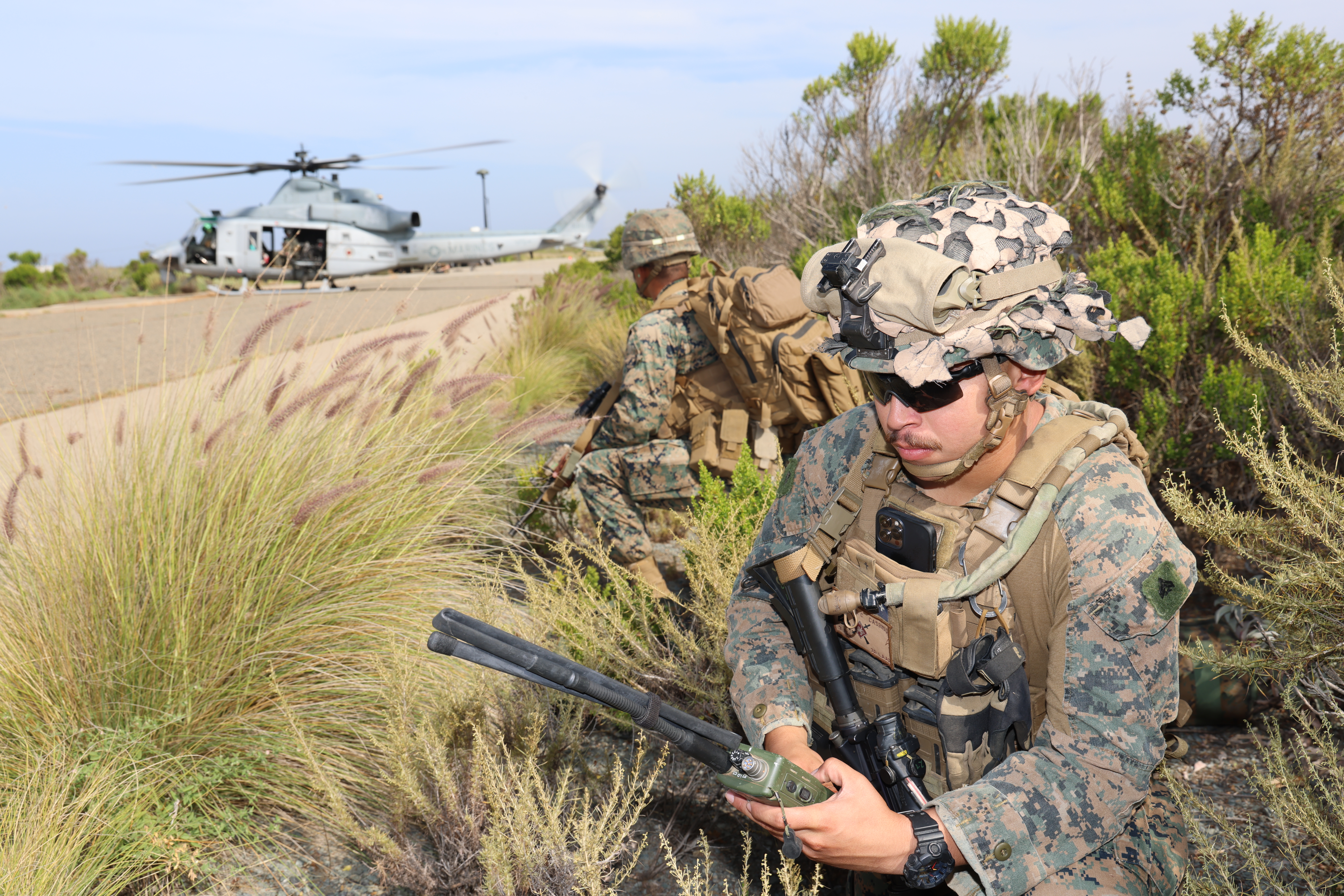
Guyette elaborated, telling us, “While many of the services within the Department of Defense talk about EABO, few are doing it like the Marine Corps and that is partly because of the heavy focus in the Marines to be fast and mobile while operating in the enemy’s backyard. EABO is hard. You read the media and people write about the F-35, and it’s supposedly this fragile fifth-generation fighter that needs a lot of support, and the Marine Corps doesn’t look at it like that. So everything in the Marine Corps, we bring forward. As the stand in force, we have to bring it forward.”

Obsidian Iceberg 23.1 had a focus on supporting F-35 Deep Air Support missions with rearmament and refueling. For deep air support, the new weapons system that VMX-1 has been testing is the GBU-53 Bravo known as the Small Diameter Bomb II (GBU-53B). With the GBU-53B, Marine F-35Bs can carry eight of them internally, maintaining their low observable signature.
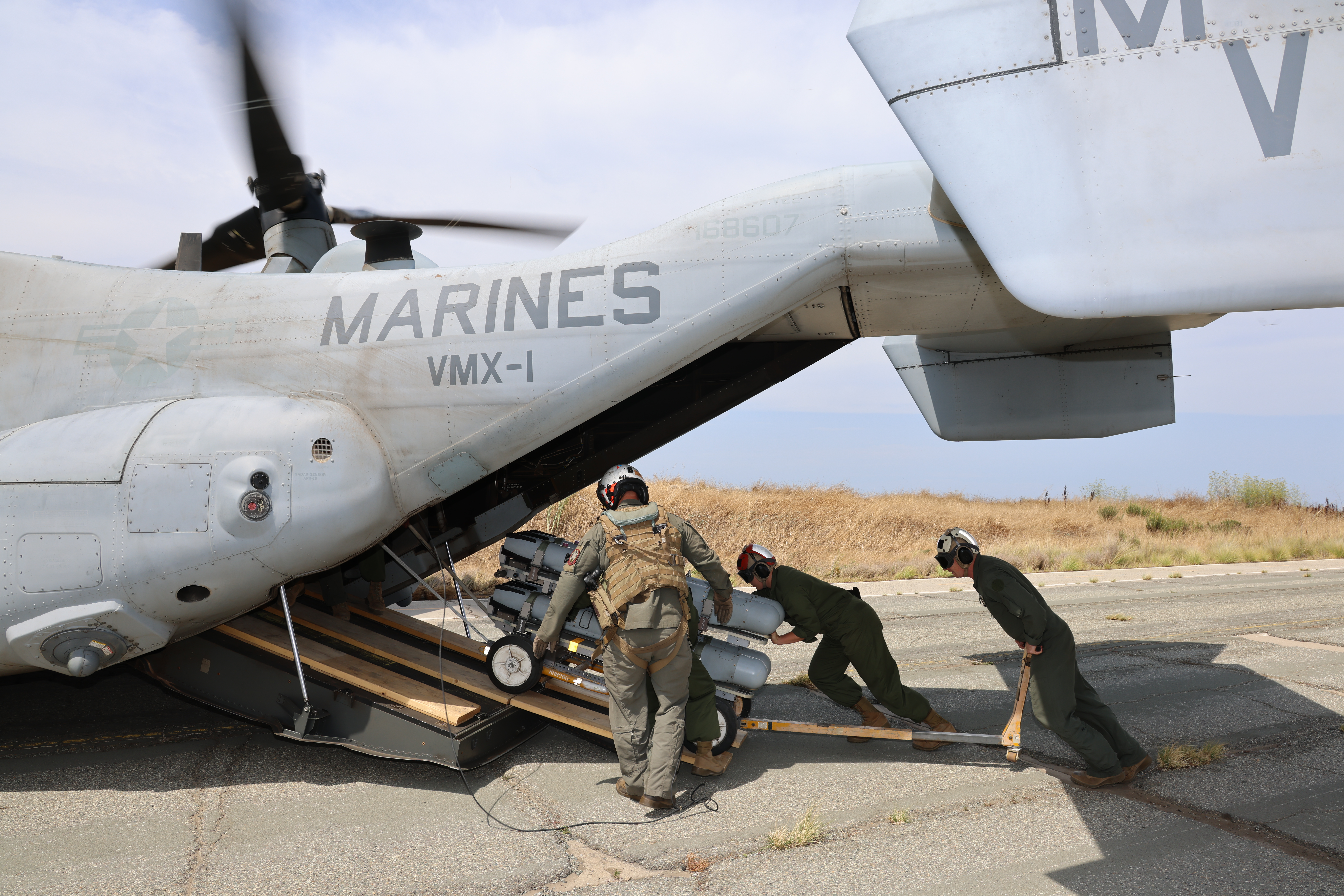
Guyette added, “That weapon gives us a networked standoff capability with a significant amount of rounds per aircraft to be able to saturate things like surface-to-air missile systems or dynamic targets, moving targets, things like that, at range or hand them off to people in other places. We see the F-35B as extremely lethal when it’s carrying four GBU-53B’s in each bay, so eight SDBs per aircraft. A division of four F-35 B’s, that’s 32 precision glide weapons with significant standoff range plus two AMRAAMs in the bay for self-defense or reactive Defensive Counter Air. That’s a real capability and so bringing that into a node rapidly negates some of the F-35 B’s constraints when it comes to things like fuel.”
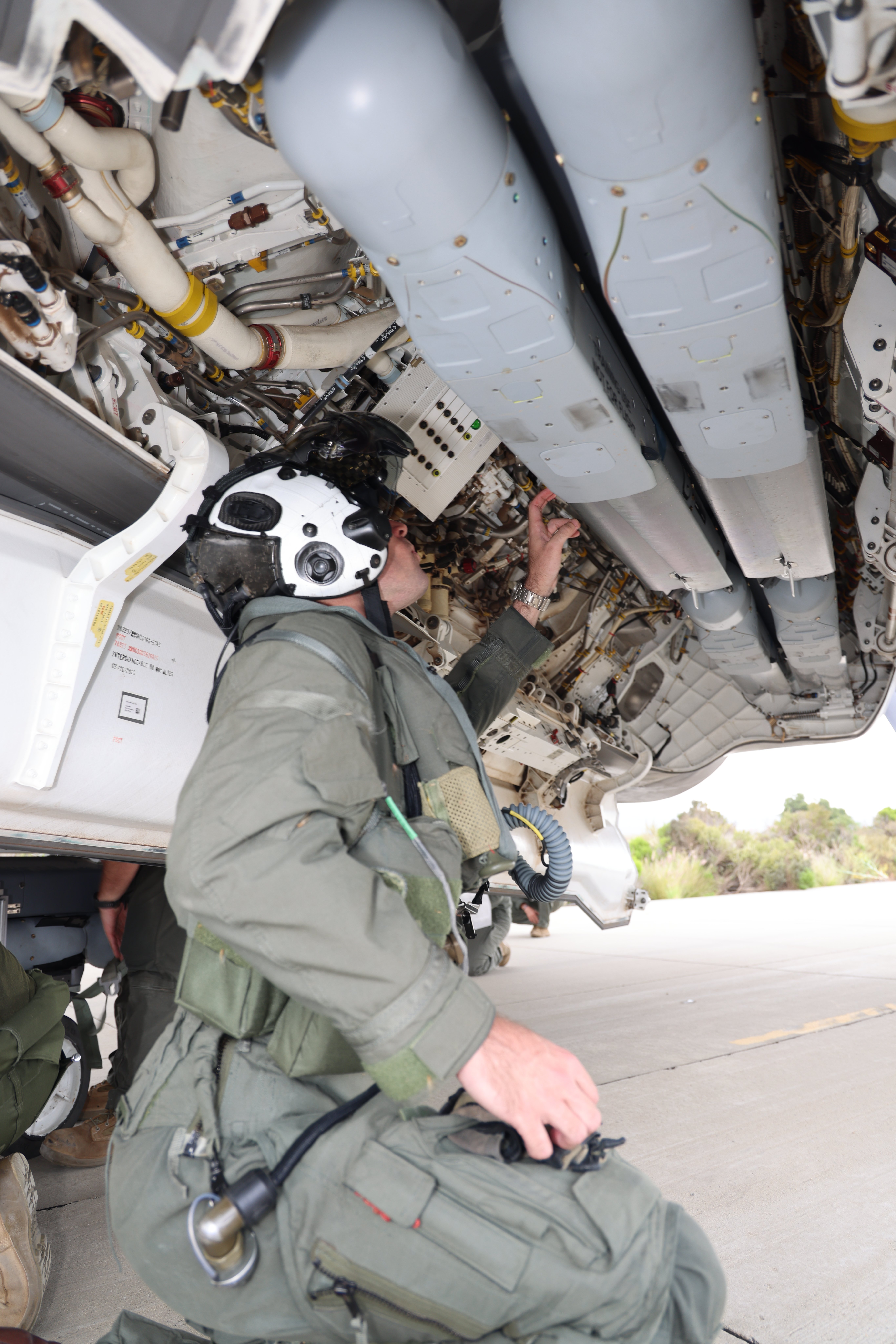
The site chosen for Obsidian Iceberg 23.1 and F-35B nodal operations was an old 50-foot-wide highway in Southern California known as the old Pacific Coast Highway. Nestled in between the busy I-5 freeway and active railroad tracks, the area would provide a challenging environment for all of the players involved, especially for the two F-35B pilots who had to land and take off from such a constrained area. VMX-1 did not choose their most experienced and seasoned F-35B pilots, but rather two Captains in order to show that the TTPs they were writing were really for the fleet.
Capt. Tanner ‘Shudderbob’ Mayberry was selected to land the F-35B on the highway. The F-35 was his first tactical airplane that he had flown and he was previously assigned to VMFA-211 across the road from VMX-1. Mayberry told The War Zone:
“In preparation for the landing with the F-35, we have various slow landings in the STOVL version that we can do all the way down to vertical landings aboard the ship. What we were executing at STOVL-101 was Rolling Vertical Landings (RVLs), which are halfway between a full vertical landing and an actual normal conventional aircraft landing like other versions of the F-35 would do.”
“To prepare for it we conducted several simulator events. The intent was for this to happen last year, and the F-35 wasn’t able to make it. So there were some studies done on both the site as well as the capability of the jet to execute these kinds of narrow-field landings, so we referenced a lot of that material. And then, for this year, we ran a number of simulators practicing both the regular mechanics as well as emergencies that could go down and what we would do. We actually ended up getting permission from the MCAS Yuma to execute landings to [the] echo taxiway here on the field to kind of start preparing ourselves for it in the jet rather than just in the simulator. Echo is about a 75-foot wide taxiway that we were executing landings.”

Mayberry continues, “Lt. Col. Christ, our aviation maintenance officer, a former Harrier pilot, was out there running LSS which is the Landing Site Supervisor and he was a safety observer. On game day I ended up launching about 30 minutes early and launched out to the north due to some significant weather kind of blowing from Imperial to San Diego. I ended up routing around to the north by Twentynine Palms and dropped down into the camp Pendleton range area. I checked in with ‘Long Rifle,’ which is Camp Pendleton’s range control, and they informed me what ranges were active with mortar and artillery fire going on and what was safe and they gave me my clearance to drop down into the range and descend.”
“Almost immediately on checking into the range, I was visual with ‘STOVL 101’ [the nickname for old Highway 101 turned into an F-35B operating area] and could see where it was at. I picked up the helicopters descending through about 7,000 feet orbiting off the California coast and made one big kind of looping descending turn, reducing gross weight by dumping a few thousand pounds of fuel to make the performance to do the rolling vertical landings. I then came in, did one pass to a low approach to look at the sight picture and where that landing would have gone.”
“Lt. Col. Christ, who’s on LSS, gave me a call to land about 200 feet further down than where it looked like I was about to land. That first initial low approach was very, very helpful actually, to get the touchdown point because I was under the impression on that first approach that I was actually going to touch down about 100 feet into the concrete on STOVL 101 when in reality, my flight path would have had the touchdown just prior to it. Able to make that correction, I waved off, came around in a kind of a normal tower pattern to an extent to about a three mile final for a second attempt.”
“I aimed 100 feet further down the runway and ended up touching down about 30 to 40 feet onto the concrete of STOVL-101. It was very controllable on touchdown. In the new system in the software load of the jet, we’ve updated the software with some of these pilot relief modes that help you land in confined sites and execute slow landings. It made it substantially easier to do this in a controllable manner.”
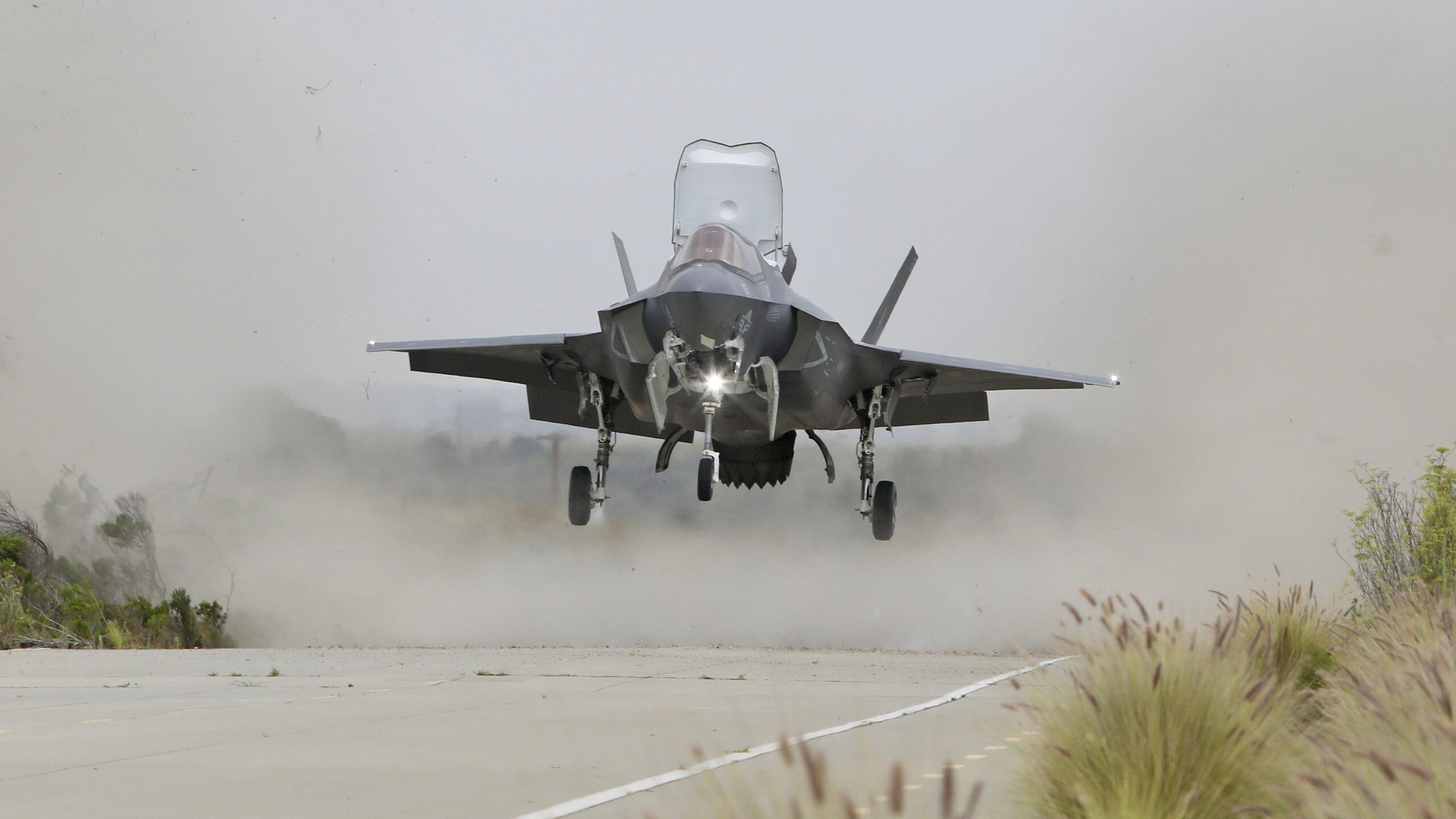
“We have two that we are able to use. One is called Delta Flight Path [DFP] and the other is Auto Top Rudder [ATR]. So with Delta Flight Path, essentially you program into the performance state of the jet, the glide slope that you want to shoot. For the Rolling Vertical Landings [RVL] we did, we were doing a four-degree glide slope to land and that’s a four-degree flight path all the way to touchdown at 75 knots ground speed. So I’ve programmed that in and then when you initiate Delta flight path, what will happen is the jet will automatically set a four-degree descend to land flight path, so that all you need to do a apply slight stick pressure to modulate up and down to be higher or lower to adjust your aim point but it sets the flight path for you.”
Capt. Mayberry decided not to use DFP on this landing since he often does a lot of flight path corrections on his own and every pilot has different ways they like to do RVLs. The newer way to do them is Auto Top Rudder (ATR). ATR continuously updates the jet’s flight control corrections for crosswind so that all you need to do is put your flight path marker (or a velocity vector in other aircraft) on your intended point of landing, and as you fly down it kicks the rudder and other flight controls back and forth to just keep you flying in that direction.
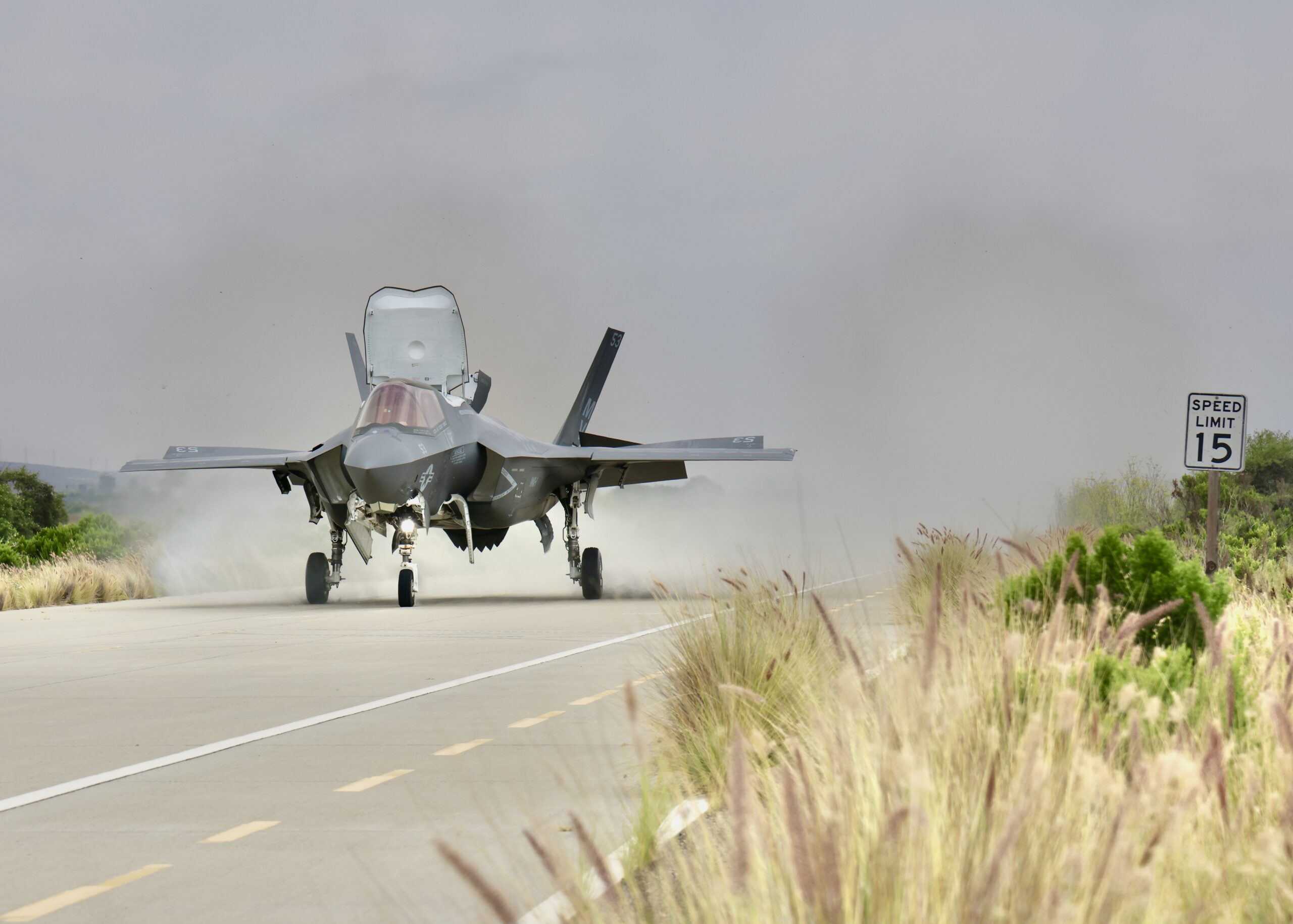
Mayberry explained “You don’t have to do any manual crabbing of the aircraft one direction or the other. ATR updates that continuously as you come down to land which is a new update as of this software build. That allowed me to touchdown. I think they measured 18 inches right of centerline and then I was almost immediately on the brakes. We stopped at 1140 feet and it was very controllable all the way from the initial approach all the way to touchdown and then stopping on the centerline.”
Once the jet landed, Mayberry made a quick and tight U-turn under the watchful eye of the LSS, opening up the weapon bay doors and shutting down, allowing for the ‘cold’ refueling and rearming of the jet. Awaiting the F-35B was a new pilot, gas, two AIM-120s and eight Small Diameter Bombs that were delivered via VMX-1s MV-22 Ospreys.
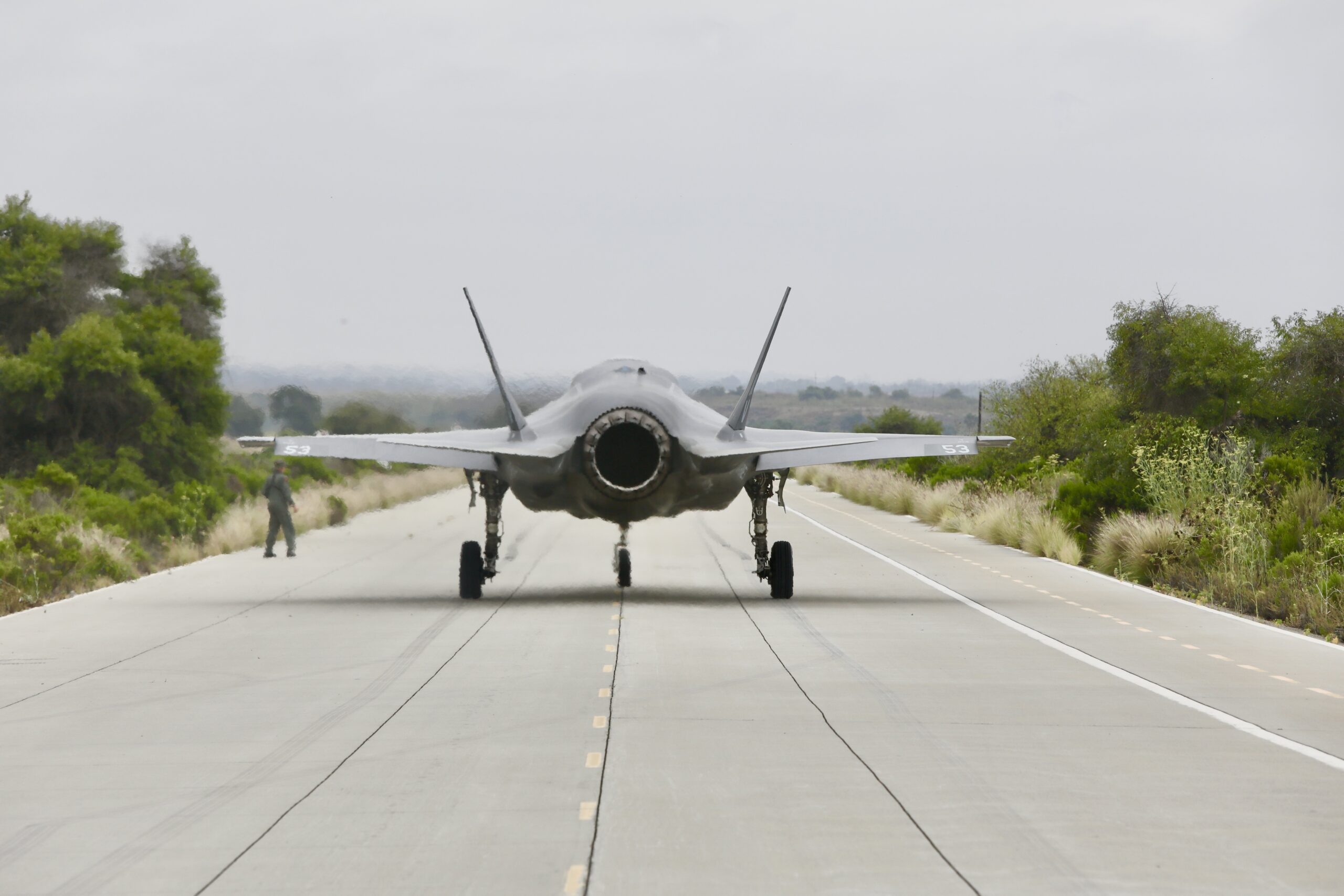
The new pilot swapping into the jet was Capt. J.C. Slaughter. He landed at the site in a UH-1Y. Slaughter and the LSS spent some time knocking back any large brush that might interfere with the landing while doing a FOD (foreign object debris) walk before the F-35B landed.
Slaughter told The War Zone:
“Shutterbob shut the jet down and then myself and the plane captain met him at the jet. The first thing they did after that was they rolled out the ordnance Marines and they loaded the eight GBU-53 Bs and the two AIM-120s. They then got out of the way and they brought the fuel truck over. They set up some pumps with gas generators to power the pumps. I hooked up the fuel to the aircraft. Setting the flow lever and giving the thumbs up, they powered up the pumps while Capt. Mayberry was sitting in the aircraft monitoring fuel state.”
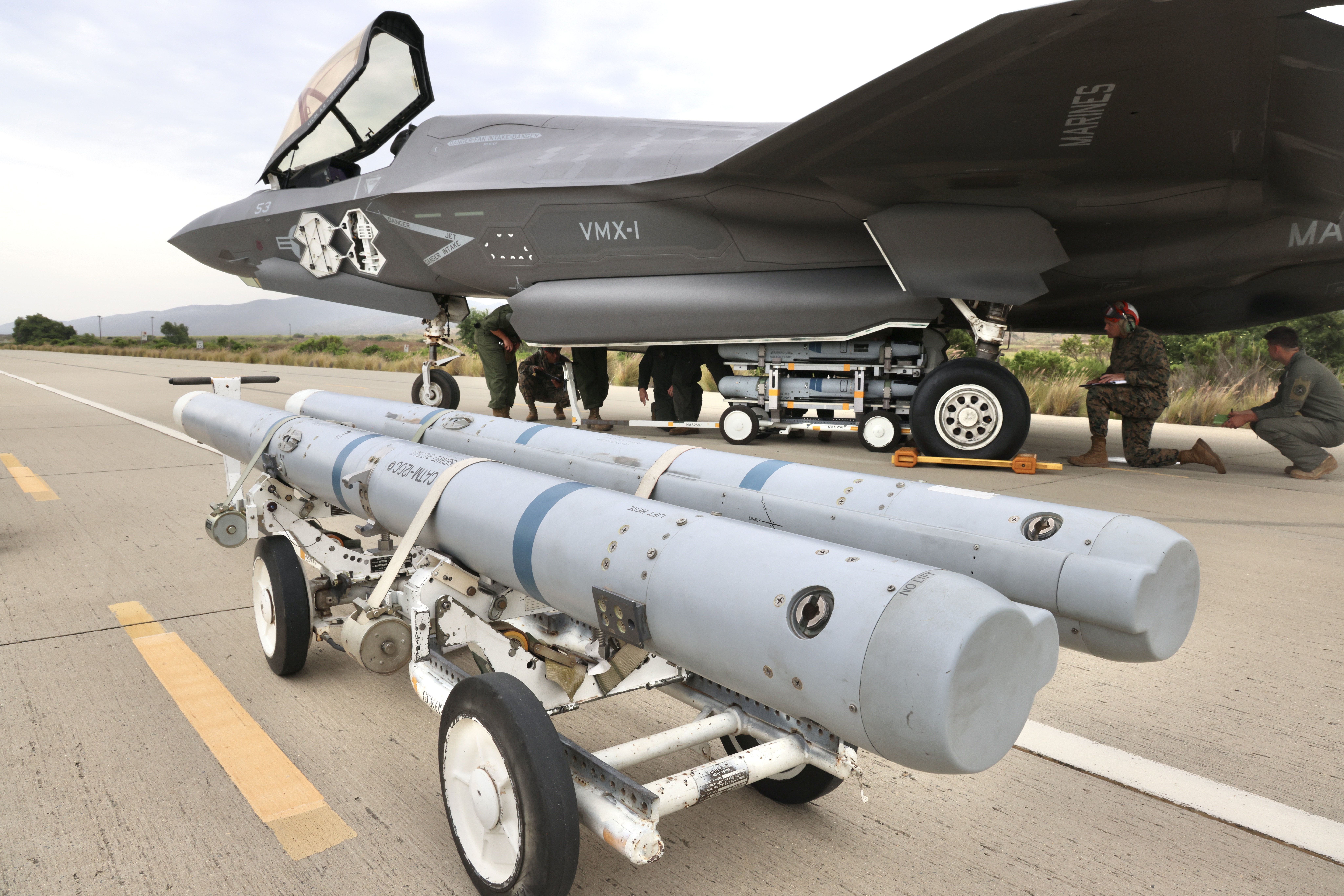
“We took about 5,000 pounds of gas and then disconnected the fuel hose and then we got out of the way at that point. I hopped in and it was a fairly normal startup with the exception that I’m looking out 500 feet to my left and there’s people driving down the interstate and off to my right there’s some trains going by, but a quick and uneventful startup. I executed a short takeoff, which means that you convert to the STOVL mode. Rather than taking off directly vertical, you apply power and you start running, rolling down the runway, and then rotate kind of like a normal takeoff, just at a much slower speed and a much shorter ground roll distance than if you were doing a conventional takeoff. So I rotated at about 80 knots here, whereas for conventional takeoff, you’re going to rotate around 145 knots.”
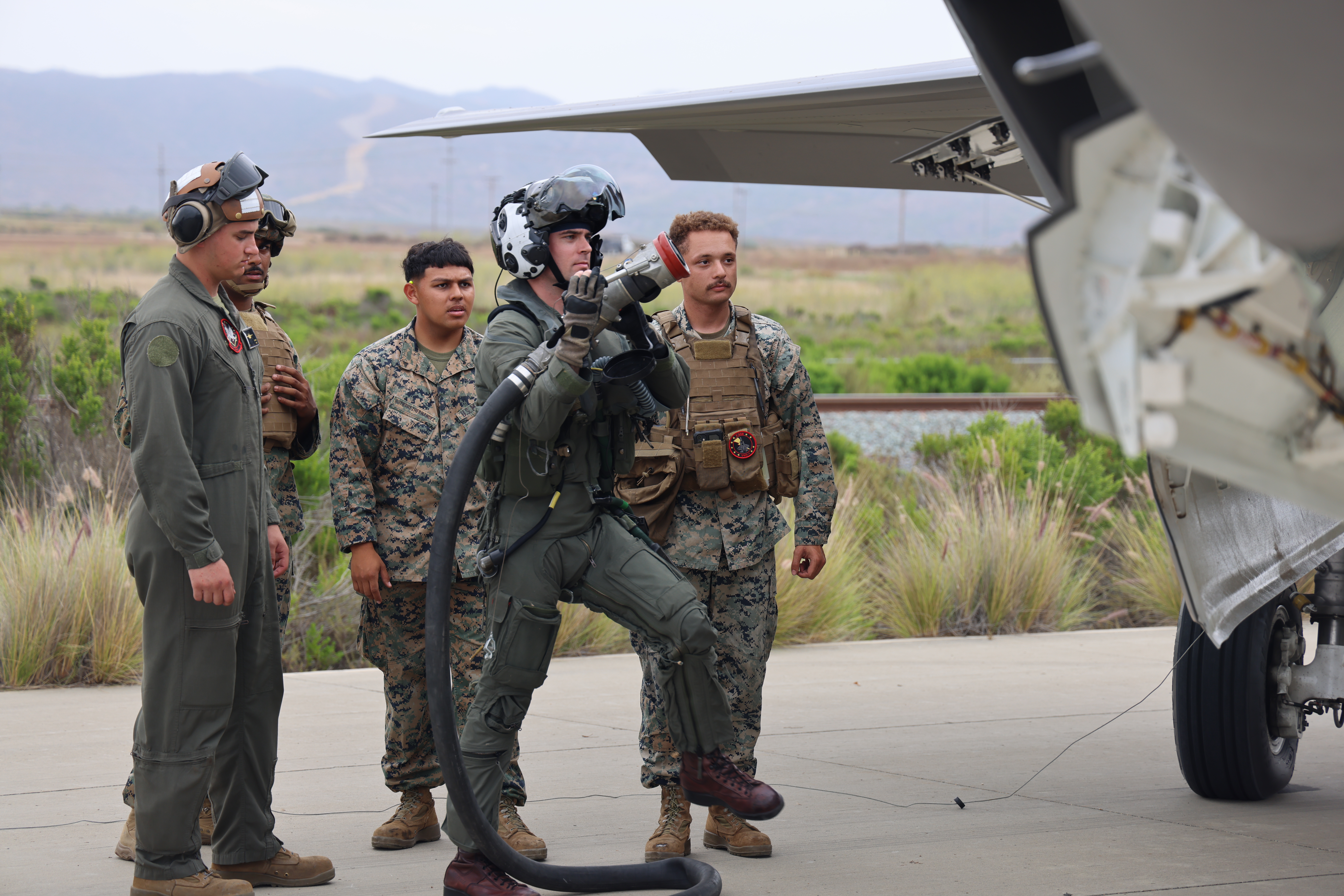
“My takeoff roll was in the ballpark of about 800 to 1,000 feet. Whereas for a conventional takeoff at the fuel state that I was at, it would have taken approximately 2400 feet. So you can cut your landing distance down significantly, basically touching down and coming to a stop within just over 1000 feet. Whereas for conventional landing, we need about 6,000 feet of runway at the absolute minimum. On a day-to-day basis, 8,000 feet is what we’re looking for. So you can cut your landing distance down by 75 percent or more and then the same thing for your takeoff distance, you can cut that down by about a third. So what that buys us is a lot more options on what kind of runway we can operate out of.”
Marines are used to these kinds of short-field “options” that require no catapults or arresting gear, as they became a reality when the Corps first started operating the Harrier. There aren’t a lot of traditional runways that are 7,000 feet long and 150 feet wide in some of the areas that Marines anticipate operating in, and those that do exist will be targeted by the enemy over great distances. But there are a lot of places where you can find 3,000 feet of concrete or higher-quality asphalt to operate from.
Describing the actual takeoff, Slaughter told us, “It definitely felt like a very narrow runway. And just past the point where I expected to rotate and get airborne, you had 25 foot tall power lines on the left and you had train signals and lights on the right with not a lot of margin for drifting left or right. It’s very easy to stay on centerline on the takeoffs. On landings, that’s where you can get more of a swerve going on, especially if you don’t apply the brakes evenly. On takeoff, it’s just a slight rudder correction in either direction.”

“It reminded me a lot of taking off from the boat. So on the boat you take off in 450-500 feet or so. You get a little shorter takeoff distance because you’re going off the end of the ship and you don’t have to climb away, you just have to fly away. So it takes a little bit more distance to take off the ground in a short takeoff mode compared to the boat. But as far as a very narrow runway that you’re taking off down and the fact that you definitely need to keep it very straight and on centerline, it felt a lot like taking off the boat.”
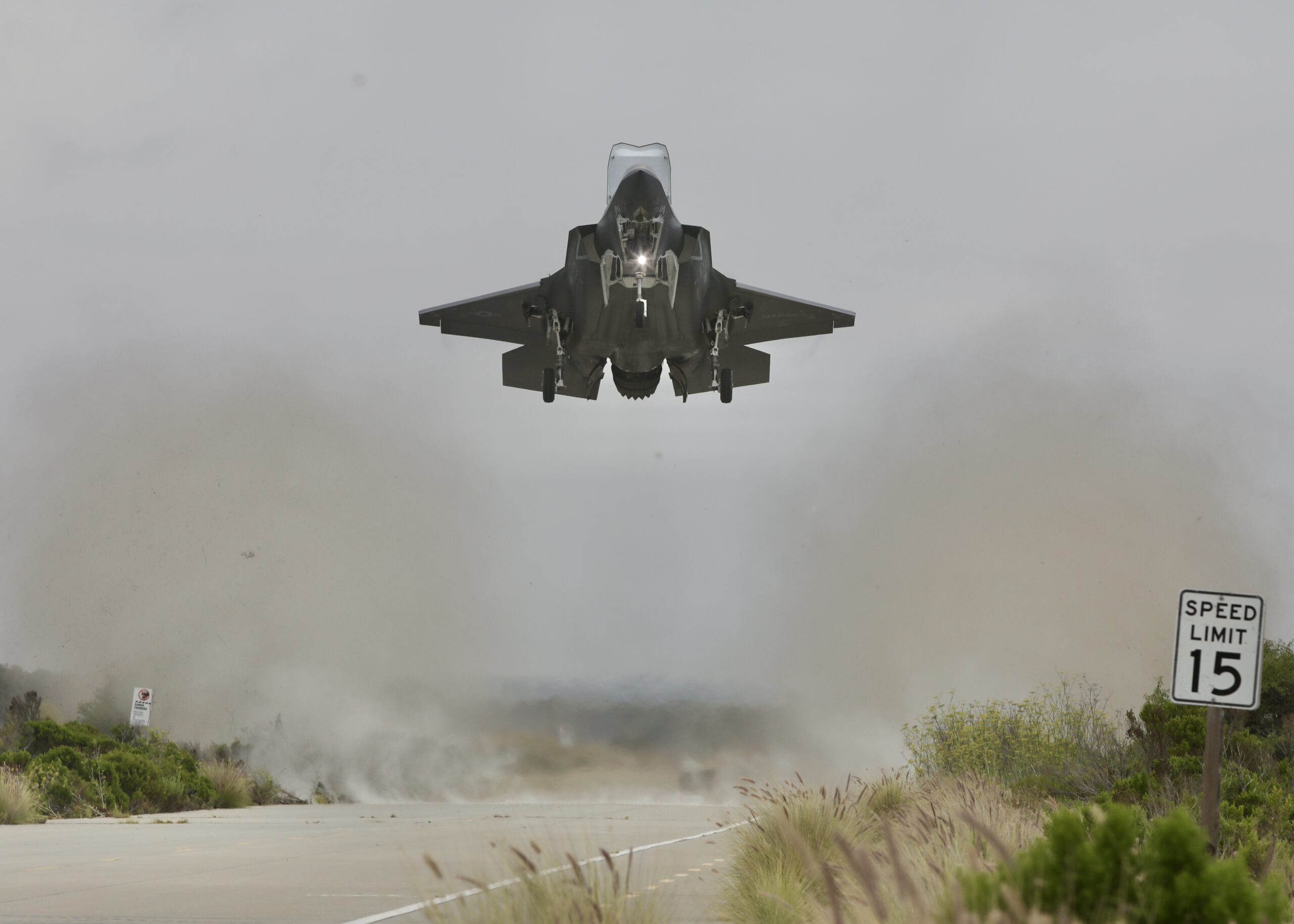
“The jet climbs very rapidly after you do a short takeoff. It does not speed up and climb rapidly. You kind of get one or the other. So I prioritized altitude over speed initially and so I rotated at about 80 knots and then climbed away about 100-110 knots, just as vertically as I could until I knew I was clear of all obstacles and then lowered the nose at that point to get speed on the jet because you have to be at a higher airspeed to initiate the conversion into conventional flight mode.”
Another major part of Obsidian Iceberg 23.1 was building interoperability with the Navy for Anti-Submarine Warfare (ASW). Planners brought in an MH-60R from Helicopter Maritime Strike Weapons School Pacific (HSMWSP) and conducted joint service torpedo loading and unloading using a recoverable exercise torpedo known as a REXTORP. This coincides with VMX-1’s parallel efforts with the anti-submarine warfare development that they are doing with their MV-22Bs known as ‘Blue Crayons.’
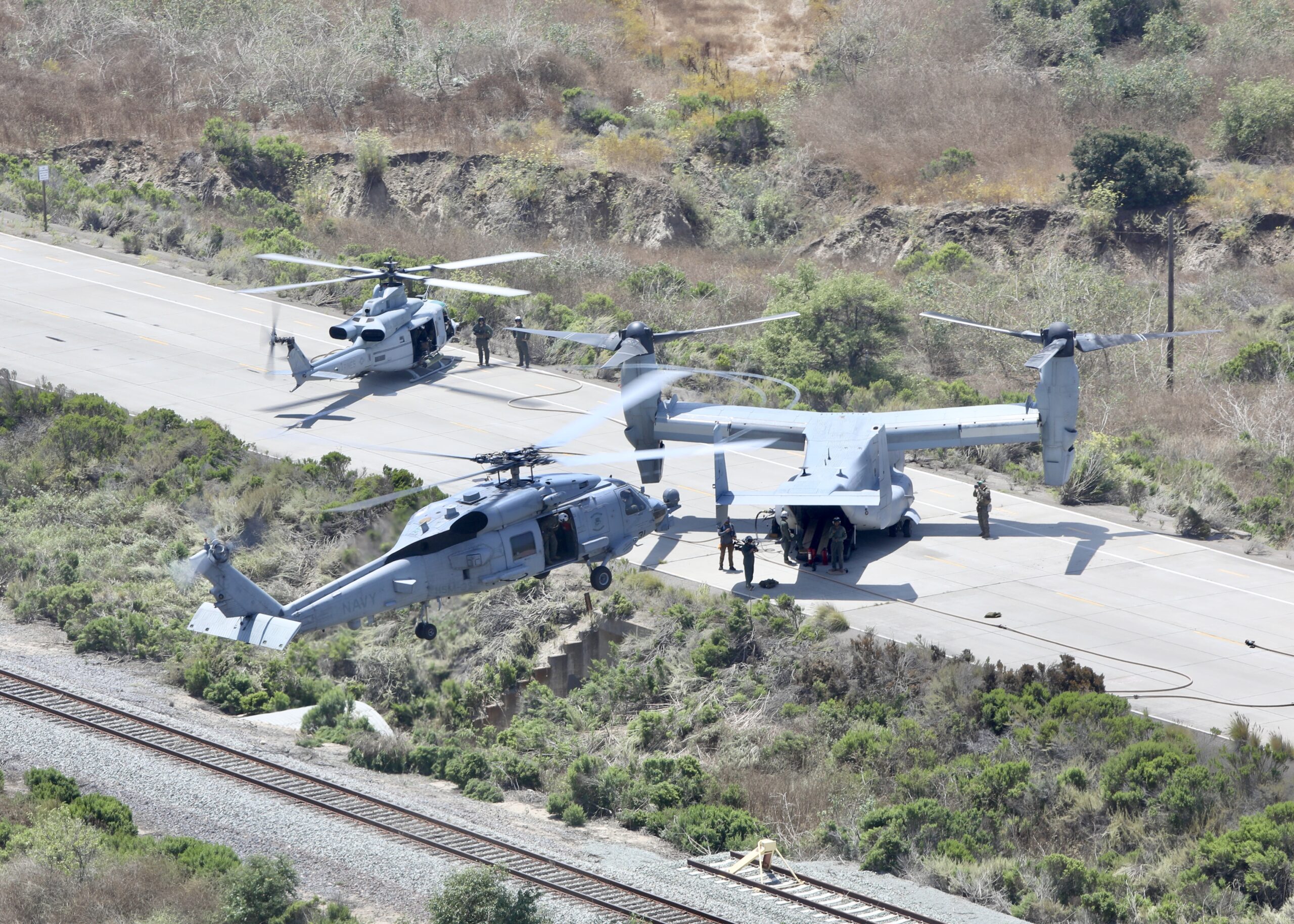
Recently a low-cost acoustic processor (LCAP) capability has been successfully demonstrated at VMX-1 to generate and then transmit over Link-16 undersea track files, while also deploying sonobuoys from the MV-22. Guyette explained, “Finding, fixing and tracking undersea targets from an MV-22 brings a lot of capability in INDOPACOM in terms of speed and agility, and the ability to put an active or passive sonar field into critical choke points. It enables the joint force to do their anti-submarine mission in a resource-constrained environment.”
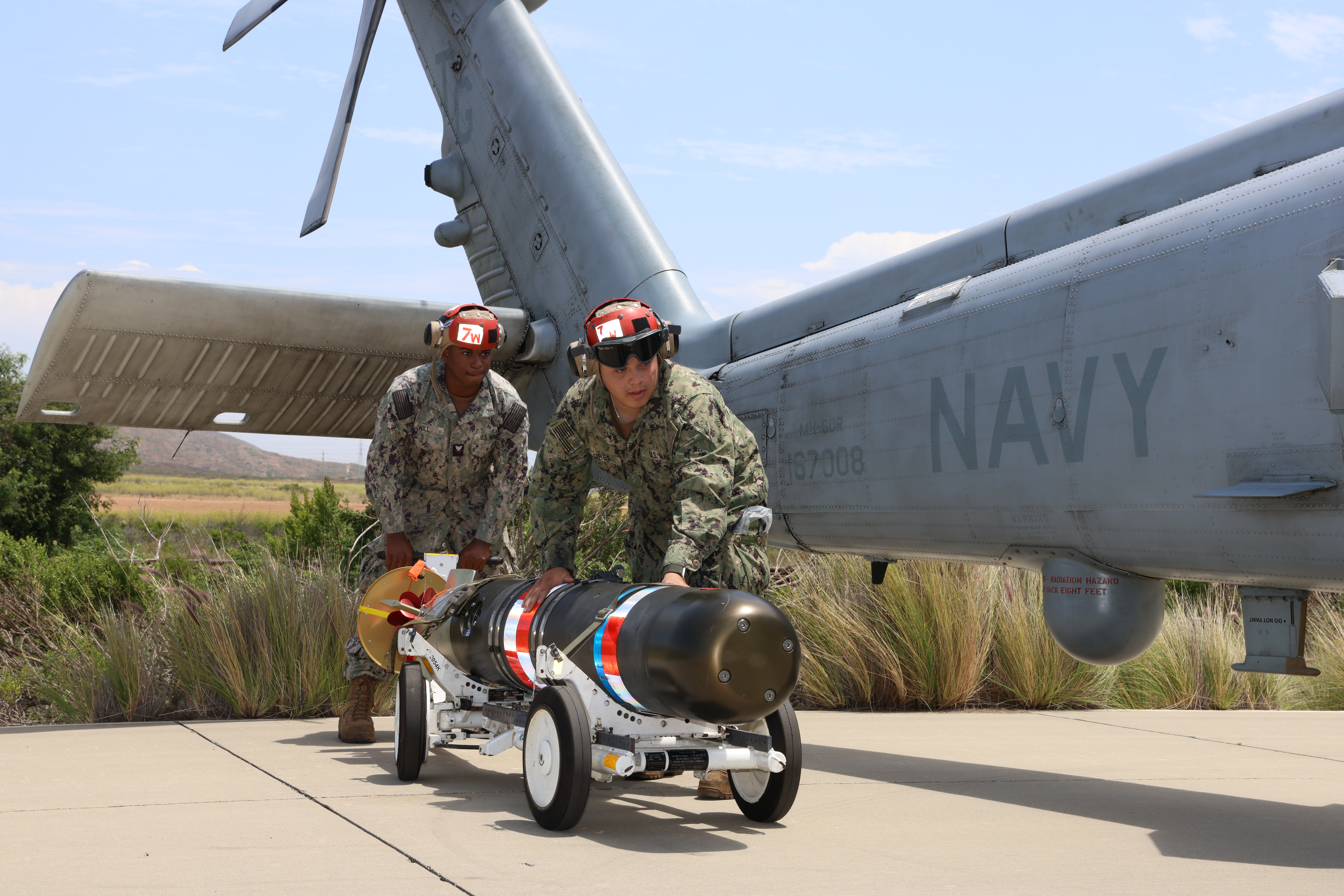
In the large areas of ocean that make up the Pacific, Marines were quick to realize that the MV-22B could be a major player with its long range and refueling capability which the Navy MH-60Rs do not have. Teaming up Marine MV-22s with Navy MH-60Rs and P-8s could certainly be a game changer. Guyette added “I’m really excited. One of the things I didn’t anticipate coming to this job was how excited I would be to learn how to kill submarines. Marines just like killing everything, you know, I mean, it’s what we do. And so the opportunity to kill something new is exciting. And so submarines are on the menu now for the Marine Corps. Developing a capability to hold air-breathing, surface, land and subsurface targets at risk, from a forward position that is survivable, broad spectrum low signature, you present a very challenging thorny problem for the adversary, when it’s very difficult to see you. And very quickly, you can drop into somewhere and re-energize your capability to basically hit them where it hurts everywhere, which is exciting.”
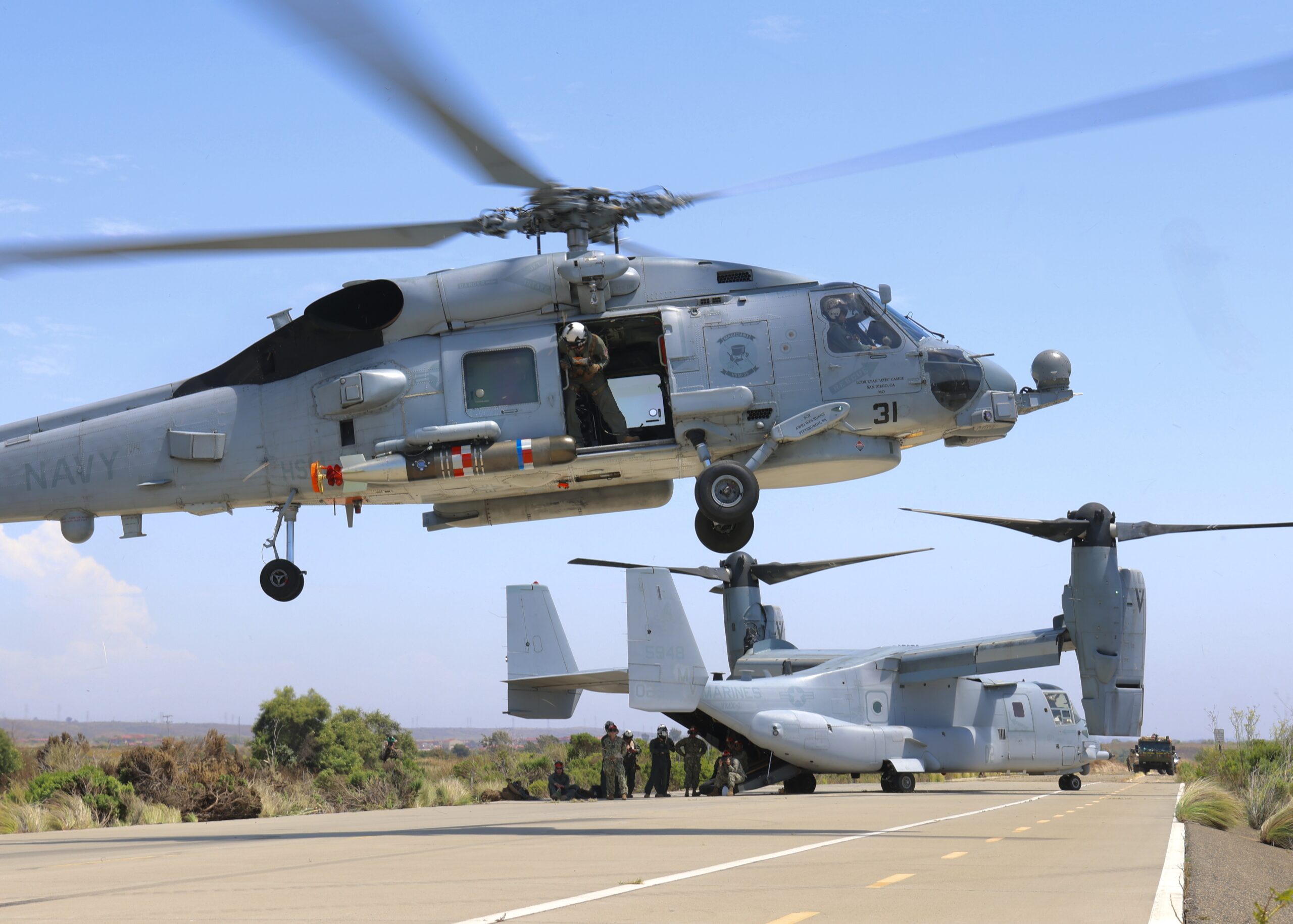
VMX-1 had to overcome some organizational obstacles between the Marine Corps and the Navy and that was always the point. Planners wanted to find the issues now. Things like ‘can Marines load a torpedo on a Navy helicopter?’ And ‘can Navy personnel ride on an MV-22 over water?’ had to be ironed out.
Guyette explained, “We’re working through all those organizational obstacles now, so that when we’re doing this for real, we don’t even have to think about it. And we’re used to it and already know each other and that’s a strong, huge benefit for the Navy and the Marine Corps team, which has always been tight. I think as we work through these problems, you realize that the Navy and Marine Corps are going to be increasingly reliant on each other to get the job done.”
Another big part of Obsidian Iceberg 23.1 was measuring the radio frequency spectrum signature throughout the evolution with the goal of trying to figure out what systems are the noisiest. They checked the signatures of the things they were relying on the most and then compared them with some of the classified assessments of the threat capabilities to see where they were the most vulnerable. To help them do electronic warfare signature measurement, the squadron brought in Marines from the Marine Corps Tactical Systems Support Activity (MCTSSA) as well as some experts from MAWTS-1.
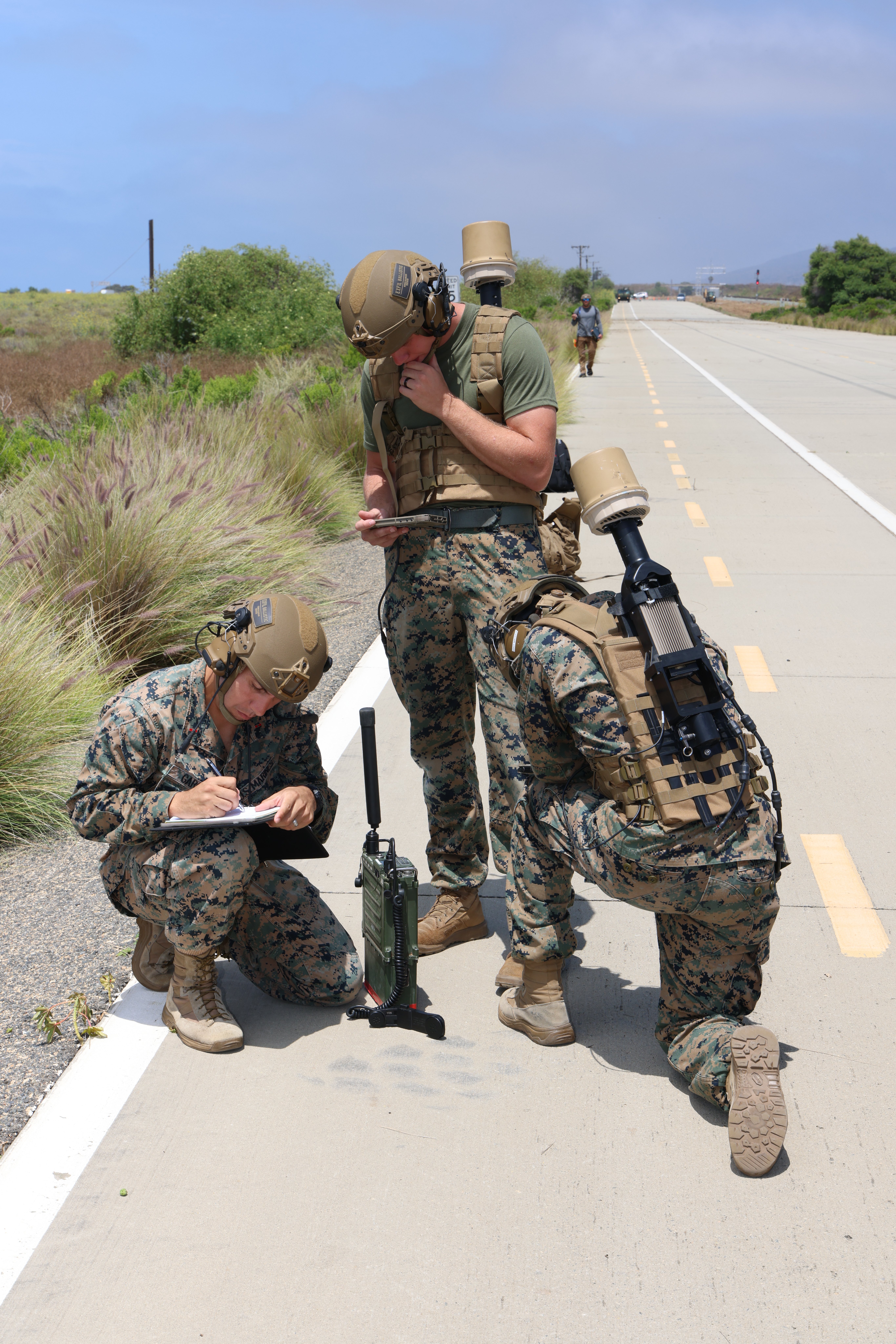
One of the main takeaways from this as well as past exercises is that every seat onboard a Marine Huey or Osprey is extremely valuable. During this training event, VMX-1 brought in Marines from the 3rd LAAD (Low Altitude Air Defense) Battalion to help against aerial targets such as drones and other aircraft. The team of three landed in the zone via a VMX-1 UH-1Y, and were able to participate in the rehearsal concept drills, scheme of maneuver developments and also watch how VMX-1 did things so they could bring back lessons learned to their community in order to integrate better into the Nodal EABO concept.

Guyette added, “The skill sets that the Low Altitude Air Defense team brings are great, but with limited seats, maybe we can use a LAAD Marine to learn how to refuel an F-35 or maybe download maintenance data and transmit over a low probability of intercept, low probability of detection Datalink. We were able to expose them to some of the tasks they may be assigned as other things that you’re doing, because one thing we do know for sure is that nobody’s sitting around in a node. Everybody’s very busy and we do it for real, the density of capabilities or tasks per human is going to be very high. We’re lucky that we have Marines and Marines are capable of doing that kind of thing. Marines are very adaptable, and they’re motivated to learn a bunch of skills and so that was a big part of LAADs involvement.”
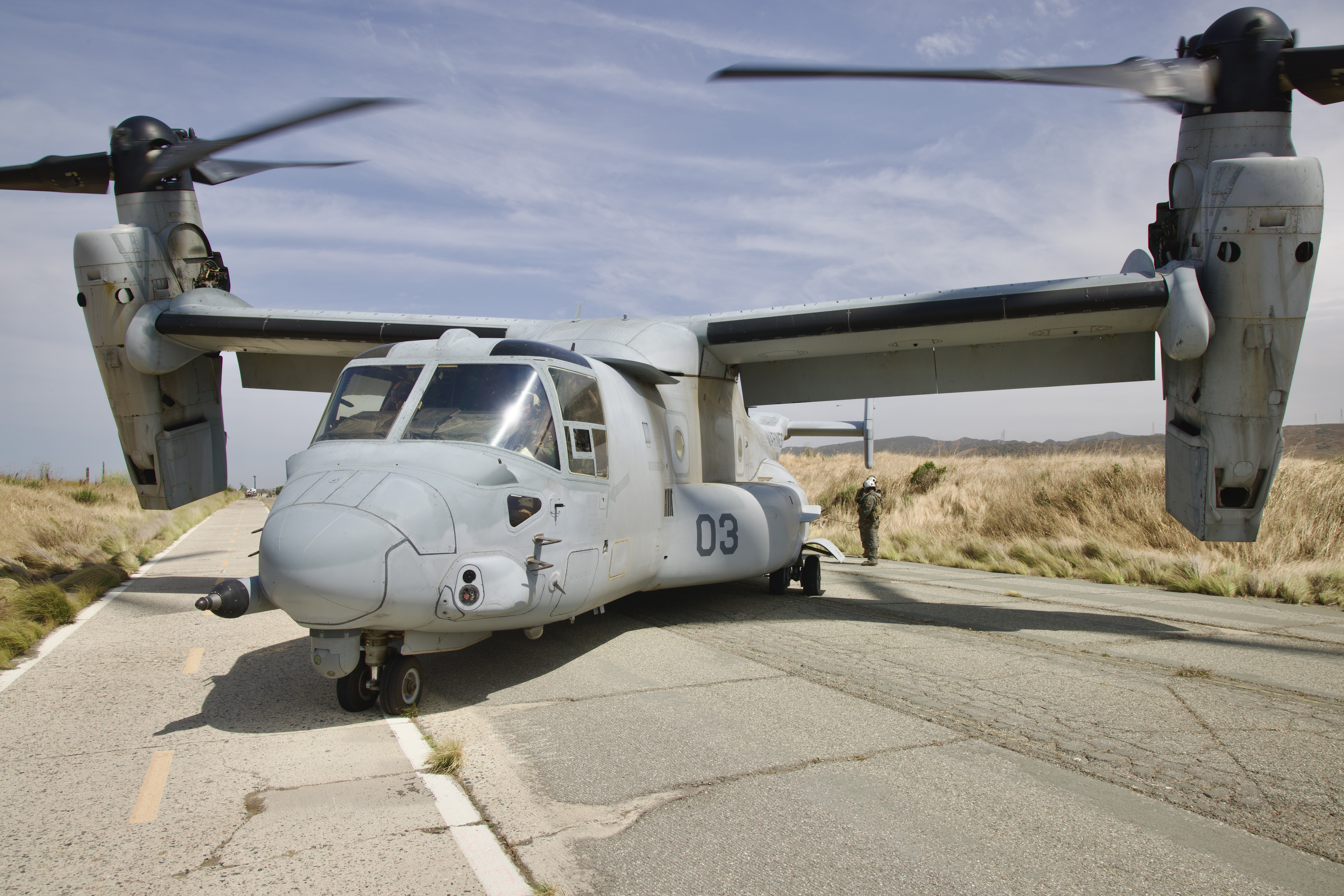
“We realized that in a… resource-constrained environment, like the node, or just in the first phases of a stand in force fight, you can’t dictate what you have on station, necessarily. So the enemy dictates when the fight starts. We’re not out there picking fights. But if the fight comes to us, we need to be ready. And so who’s on station? Is it a combination of Navy people? Is it a combination of Marines and Navy people? Is it all Navy or all Marines? Who’s there? What do we have? What puzzle pieces do we have to solve this problem? And so we’re looking to build ultimate flexibility in terms of capabilities, skill sets, qualifications, familiarity, and things like that. And so those are the kinds of relationships that we’re building right now. And so we are all coming together in order to develop that sort of operational flexibility that’s going to be needed to conduct the anti-submarine warfare from a forward position in Indo-PACOM.”
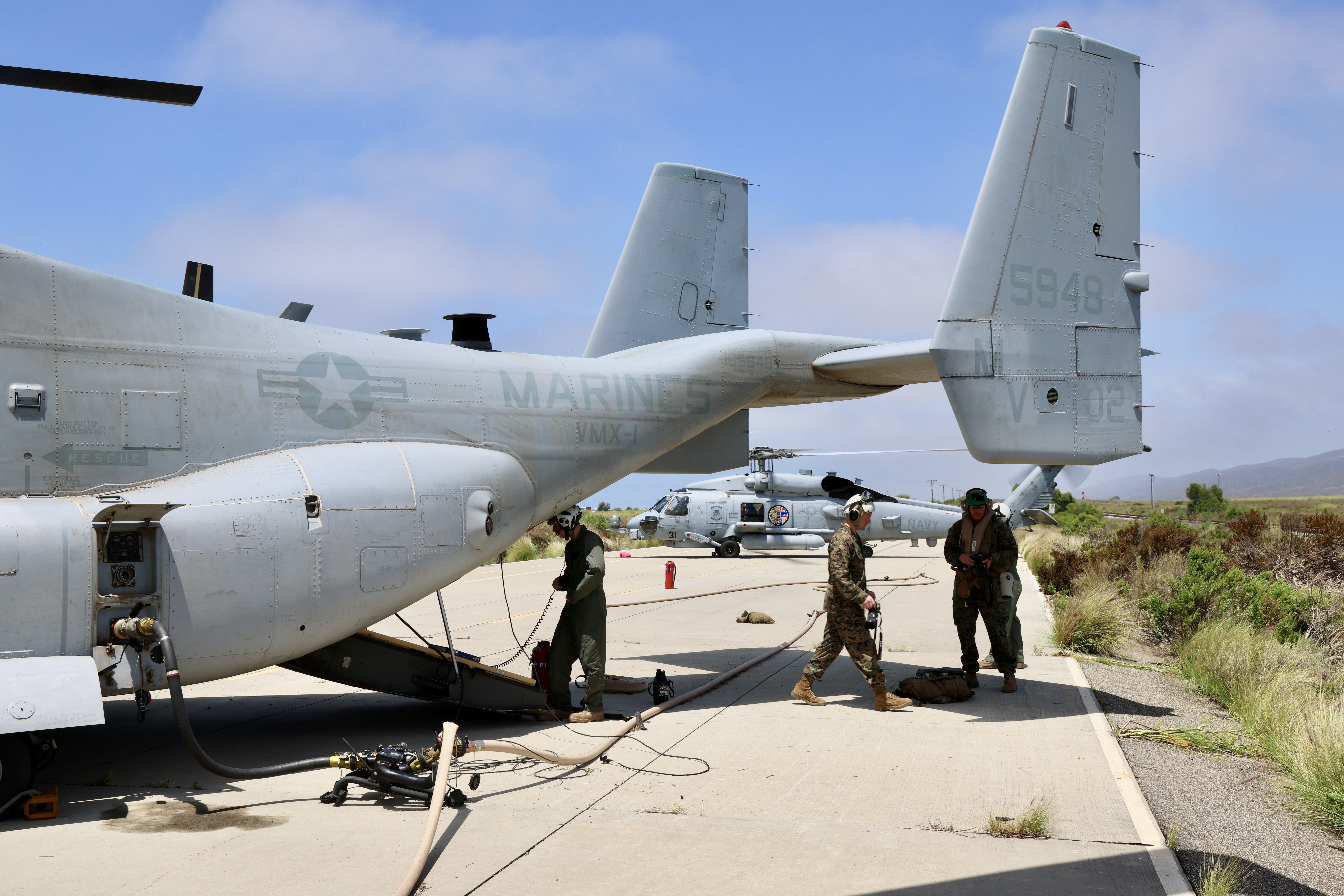
Another service that joined in on the training event was the U.S. Air Force which provided an MQ-9 Reaper from March Air Reserve Base to provide overwatch. The integration of the MQ-9 was very important to VMX-1 as they are receiving their own two MQ-9s as part of the MUX-MALE program. They used the aircraft in the C2 (Command and Control) role with Marines in Yuma wirelessly controlled to the ground station at March as well as having some of their Marine MQ-9 pilots sit in the ground control station at March, as well. They provided overwatch, command and control and datalink relay.
One of the biggest challenges with EABO operations is the ability to get large amounts of fuel to remote areas. Marines at VMX-1 and MAWTS-1 are looking at innovative ways to address the problem and will likely be included in future iterations of Obsidian Iceberg. Guyette told us, “We used MWSS-372 [Marine Wing Support Squadron 372] for fire support and fuel. Fueling is something we ‘white carded’ for this event as it is something we are still in development on with regard to how we deliver large amounts of fuel. We brought truck fuel in for this event but we are trying to develop CONOPS. There is a lot of progress and effort being placed in the fueling area right now with some tactical demos planned for this upcoming WTI course, with aerial delivered fuel bladders and things like that.”
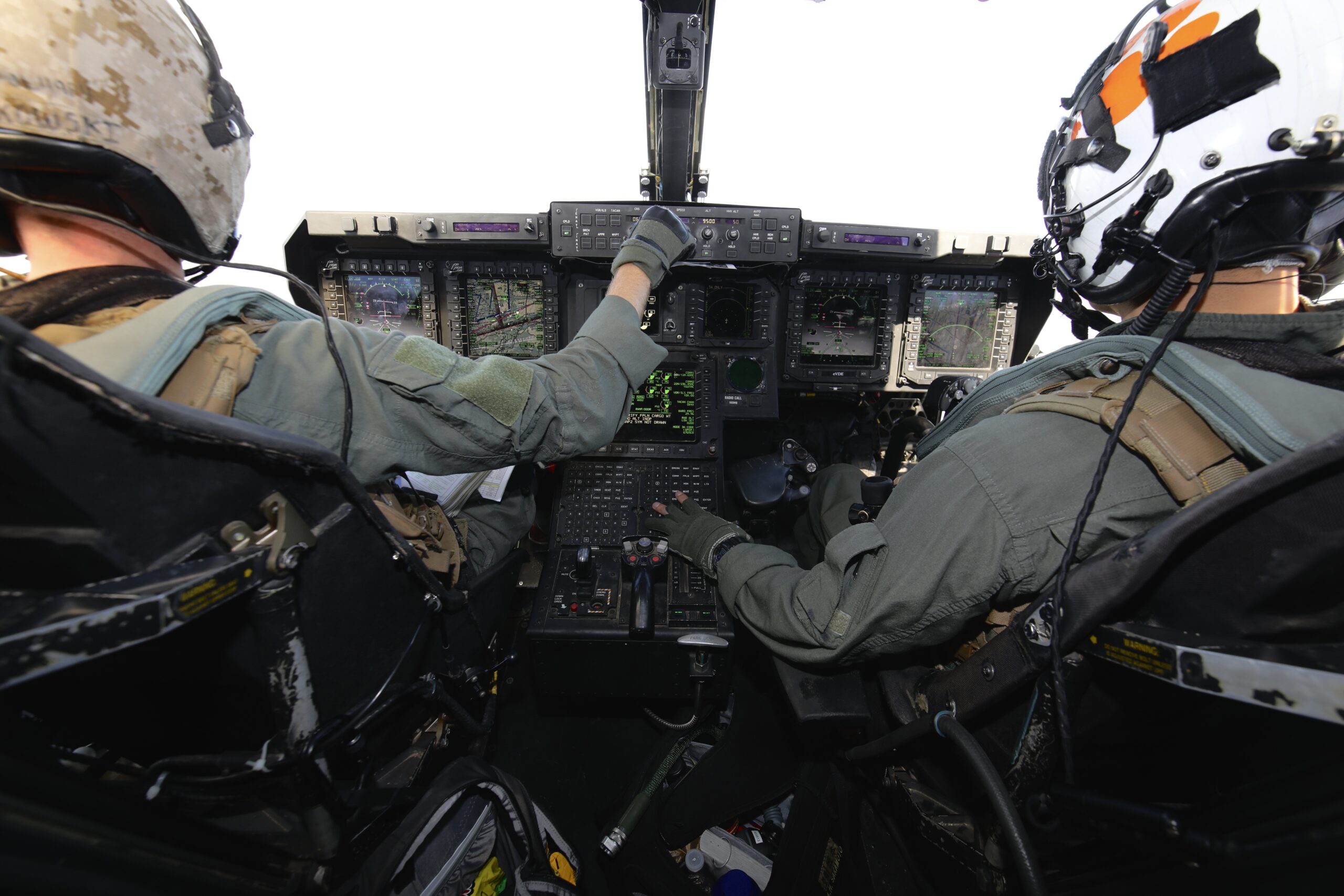
During the entire exercise, VMX-1 used two of their UH-1Ys to conduct a host of tasks as the H-1 community prepares for a major upgrade with the introduction of Link-16 onto the aircraft. Speaking about the role of the UH-1Y drawing the exercise, Guyette explained “Most people know the Huey as a C2 platform and it was used extensively in that role during ‘Obsidian Iceberg’. With a SATCOM capability via MUOUS, their PRC-117 Golf radios and the appropriate crypto they did a really nice job of getting that thing set up so that we could communicate real-time back here to the drone or the MQ-9 overhead to all the players, basically all across the country to communicate status updates, and we had people back here in Yuma running that C5IRST Marines running that we have a marine terminal with MUOUS in one window and the feed from the MQ-9 in another window providing updates and queuing and situational awareness.”
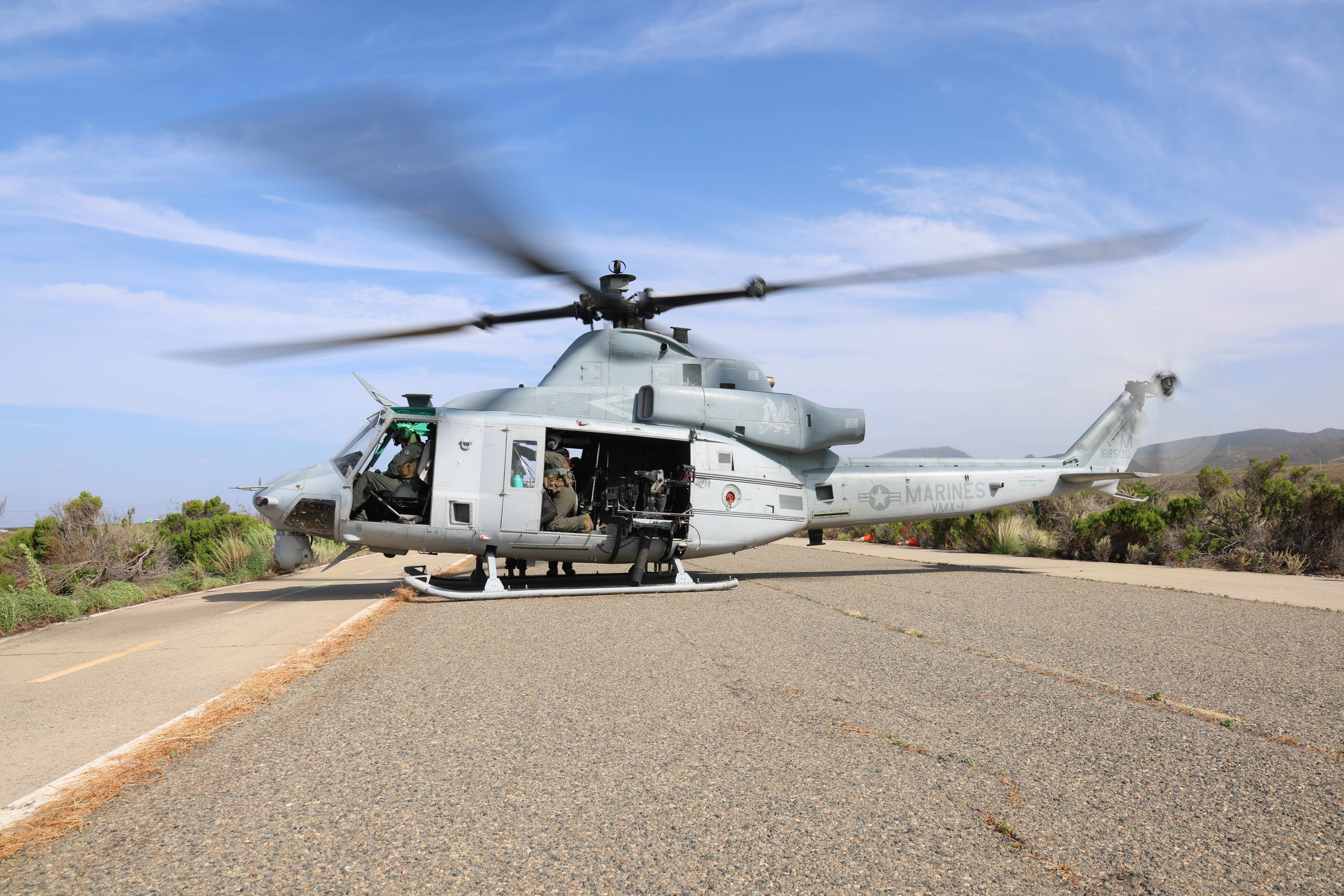
While Lt. Col. Guyette is a fighter pilot by trade, he spent a few months at Camp Pendleton before going to Yuma so he could learn to fly the H-1, which gave him a first-hand perspective as to how the H-1 community operates. Guyette told us “H-1s serve as the on-scene connective tissue for the C2 effort. UH-1s are great in a lot of things and traffic cop is a good one. As people are coming in and out of the node, the UH-1 is basically joining up and escorting people in there. They did a really nice job of assessing the weather in real-time. EABO typically happens close to shorelines and shorelines have microclimates that change rapidly and so the expertise of the H-1 crews, and their ability to assess rapidly changing weather patterns really carried the day, specifically on the first day when we were able to make effective rapid calls to call audibles to change the plan based on weather.”
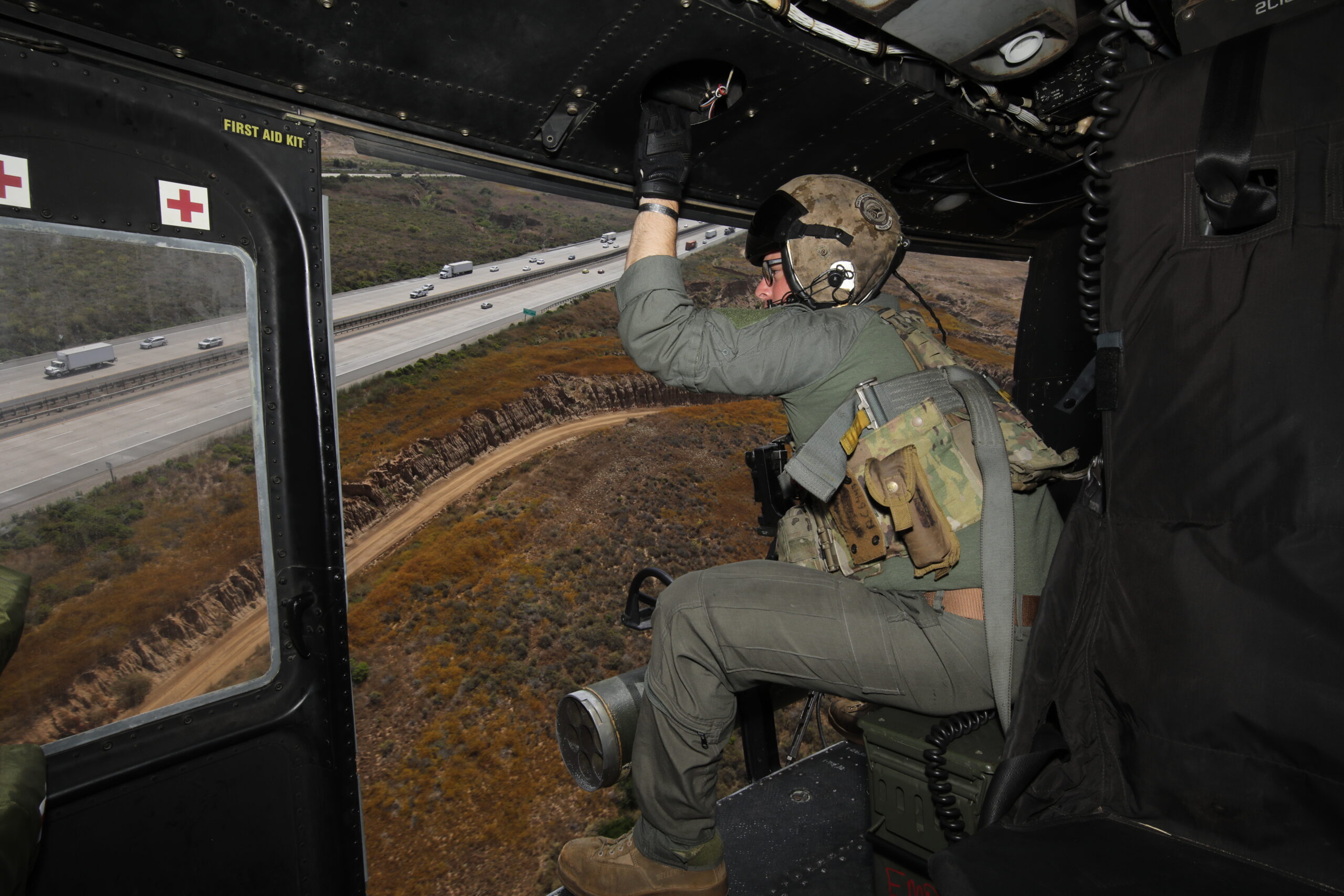
“That’s the strength of the Marine Corps — that we do a really tight integration of multiple capabilities or platforms to basically produce a force that is greater than the sum of its parts. The Marines are capable because we integrate air, artillery, infantry and armor units and things like that all together, right? And so the VMX strength comes from executing our traditional OT (operational test) role, but also, in this case, a demonstration or experimentation role as an integrative force.”
The Marine Corps’ leadership clearly recognizes the value that VMX-1 and Obsidian Iceberg bring in terms of innovation and problem-solving with regard to the ever-evolving EABO playbook. It will be interesting to see how the exercise morphs as the capabilities to take the fight to China in the Pacific become more established.
Stay tuned.
Contact the editor: tyler@twz.com
